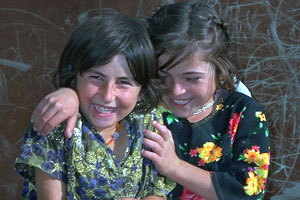2.2 Gender disparity
The difference between a broken community and a thriving one is the presence of women who are valued” (Obama, M., State Department Women of Courage Awards, 2009).

Unequal from the start
Girls, in particular, experience many barriers, even before they are born. The Save the Children publication An Equal Start (2011) explores how a child’s chances of survival is affected by discrimination against women and girls. Chapter 1, “The impact of gender discrimination on child survival,” describes how gender-based discrimination affects maternal and child health and directly or indirectly influences the likelihood a child will survive and thrive.
What does this chapter reveal about the interconnectedness between child survival and maternal health and well-being?
The chapter describes several direct, immediate, and underlying causes of child mortality related to gender. Which of these are prevalent in your context? Are there others you would add?
What strategies would you recommend for tackling these causes?
This document was published in 2011. Do you think that child mortality trends have changed where you live? Why or why not?
When girls do survive, their opportunities to reach their full potential are compromised by a range of obstacles including gender-based violence, child marriage, lack of voice or recognition, and limited or no educational opportunities. The Executive Summary from Save the Children’s report Every Last Girl (2016) describes the range of barriers experienced by girls.
The report lists seven barriers to girls’ equality. Which seven are prevalent in your context? Are some more prevalent than others? Why?
In your opinion, how would addressing gender equality increase maternal and child outcomes?
If you were designing a program to reduce barriers to girls’ equality, which barrier(s) would you address first? Why? What would you do to address the barrier(s) you identified as top priority?
Child marriage is a particular barrier for girls. Over 12 million girls under age 18 are married every year and these girls are more likely to experience intimate partner violence including sexual violence (Girls not Brides, 2020).
Consider…Tamrea – Married, pregnant, and abandoned at age 12
I was given to a husband at 12. I wasn’t happy to get married at that age….Read more
In what ways has Tamrea’s early marriage shaped her future and the future of her baby?
Why do you think Tamrea says “if a girl goes to school she can have a better life?”
Read the full Every Last Girl report from Save the Children

The Sustainable Development Goals (SDGs) recognize that gender equality and women’s and girls’ empowerment is important for economic and social development. In other words, when women and girls have equal opportunities, societies do better. SDG 5, “Achieve gender equality and empower all women and girls”, strives to eliminate gender-based discrimination and violence, enforce women’s and girls’ rights to health and education, and generate opportunities for women and girls to become agents of change in their communities. Key to successfully achieving SDG 5 and the nine accompanying targets is women’s and girls’ education.
Unequal opportunities for education
There is no justification – be it cultural, economic or social – for denying girls and women an education. It is a basic right and an absolute condition for reaching all the internationally agreed development goals. It is through education that girls and women can gain the freedom to make choices, to shape their future and to build more inclusive and just societies” ~ Irina Bokova, Director-General of UNESCO (UNESCO, 2015).
The following 2018 infographic from Global Partnership for Education provides some very clear data on educational disparities for girls.
Now check your recall of this data.
What have been some of the advances in girls’ education?
What challenges remain globally? In your context?
This infographic is specific to girls’ education. What might an infographic on boys’ education look like?
Yet, in the report State of the World’s Mothers 2005: The power and promise of girls’ education, the first key finding is Girls’ education is a proven and powerful investment in the well-being of present and future generations of children.
The following link provides an overview of the annual report on gender by UNESCO. The report provides a snapshot of gender equity in education within a broader framework, taking into consideration broad social and economic contexts as well as policies and systemic factors, a truly ecological approach.
What stands out for you in this report?
How is your own region faring in comparison with others?
The report mentions that donors prioritize gender equality in their education budgets but must make sure this is sustainable. What economic and social factors in your region are needed (if any) to sustain equal educational opportunities for girls?
The following UNESCO document illustrates how education, particularly for women and girls, can transform lives, families, and societies.
Why is equitable access to education important for boys and girls, families, and societies, for achieving the Sustainable Development Goals?
How does a mother’s level of education influence child survival, growth, and development?
Why is educating girls such a good investment? Describe possible future impacts on girls themselves.
What about the impacts on families and societies?
UNESCO’s World Atlas of Gender Equality in Education (2012) and Global Education Monitoring Report (2016) examine gender parity in education. Globally, more and more countries are achieving gender parity, especially at pre-primary and primary levels. For example, in 2014, 63% of countries achieved gender parity in primary school or grades (UNESCO, 2016). Yet, gender disparities continue to exist within regions and countries because of factors such as wealth, geography, and cultural practices and expectations of boys and girls.
The global snapshots suggest that gender parity has been achieved almost everywhere at the pre-primary level. Given that enrolment rates vary considerably within and across countries and the global pre-primary GER is only 44% (UNESCO 2016), how do you think these stats might change if enrolment rates were higher? Would there still be gender parity?
In countries that have achieved gender parity, do you think boys and girls have access to the same quality of education? Why might families choose to send boys and girls to different schools? What impact might this have on their learning, development, and future opportunities?
Find your country on each of the maps. How does your country compare with other countries in your region and the world for each level of education? If your country has achieved gender parity, what strategies do you think led to this? If your country is male-favoured or female-favoured, why do you think this is? What strategies could help achieve gender parity?
Many NGO’s are working hard with communities and governments to support girls’ education. Explore the information from Plan International’s website.
In conflict-affected contexts, boys and girls experience changing and new barriers to education. Boys may drop out of school to support their family financially as older siblings or fathers are in prison, have left the country, or have joined the conflict. As boys get older, they too may drop out to join the fight. Girls, with their numerous existing challenges, are particularly vulnerable in conflict-affected contexts. Girls in conflict-affected contexts have the worst education outcomes, especially as they become adolescents. Existing and new threats directly or indirectly influence whether a girl child goes to school, stays in school, and learns.
Read the executive summary of the following report on girls’ education and conflict.
What are the main direct and indirect threats to girls’ education in contexts affected by conflict?
The report suggests adopting a multi-pronged response involving multiple sectors and actors. How would this look in your context?
The report focuses on how conflict affects girls’ education. In what ways do you think boys’ education may be affected? What might be the direct and indirect threats to their education? What strategies would you suggest to overcome these threats?
Gender socialization
During early childhood, children acquire a sense of themselves, including an understanding of what it means to be a boy or a girl, a man or a woman, in their homes, communities, and societies. Adults at home and in preschools and primary classrooms model gender expectations and teach children the “accepted” behavior. This may be done consciously (i.e., saying to the child that girls’ do not play with blocks) or unconsciously (i.e., praising girls for sitting quietly and punishing them when they are running around). Preschools are an opportunity to ensure boys and girls have equal opportunities for education and influence children’s gender identity.
The PLAN International 2017 report, Gender Inequality and Early Child Development can be downloaded from the following site. On page 19 of the report, the influence of gender socialization in the early years is explored.
How do children’s experiences and interactions before they start pre-school shape their gender identity and understanding of gender norms?
How might these gender norms affect the kinds of experiences boys and girls might have at home, in preschool, in school, as they grow older?
Do you see efforts by preschools and primary schools where you live that challenge gender stereotypes or reinforce them?
PLAN International conducted research on gender equality and ECD in different countries in Asia.
This study finds that gender stereotypes are reinforced in the preschool through printed materials, activities, and teachers’ expectations of and interactions with boys and girls. How are boys and girls represented in preschool curricula in your country?
Do teachers treat boys and girls differently? How so?
If you were the project manager, what steps would you take to ensure the materials, activities, and teachers’ practice are gender-responsive?
The following World Bank website includes background information, key issues, data, and links to relevant resources related to girls’ education.


